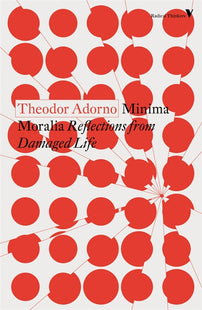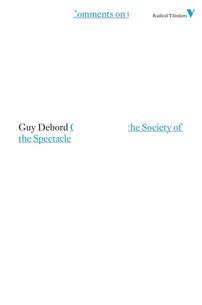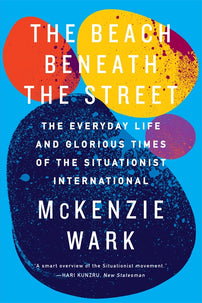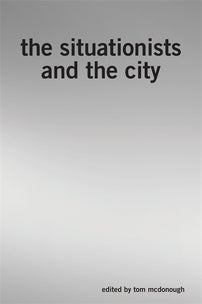Nothing is Any Longer the Opposite of Anything: Guy Debord’s The Society of the Spectacle Today
Eric-John Russell demonstrates why a return to Guy Debord's most famous work is all the more pressing at a time when irrationality no longer takes anyone by surprise.

At a time of so much change, a critical theory of society is confronted by the challenge of a moving target. When each new day brings with it a new disaster, the horror lies in the rhythm with which we are acclimated, without time or reflection, to a new ordinary of social amnesia. It is in these moments that it would seem odd to return to and assess the legacy of Guy Debord’s 1967 The Society of the Spectacle. Yet if the tropes surrounding Debord’s diagnosis have faded into the background with recent scholarship[1], we might inquire whether a critical theory of capitalist society that lays emphasis on a unique form of social domination by images, representations and appearances, might offer some coherence within such incoherent times.
It is often forgotten that the society of the spectacle is less a critical theory of appearances than it is a theory of the organization of appearances. The former misnomer gains traction with the frequently and cynically bemoaned dissemination of images themselves, exemplified for instance in the advertising and entertainment industries. Yet as his films and autobiographies can attest, Debord held no grudge against images per se. Instead, the concept of the spectacle refers to a principle of inner organization that respects a seemingly endless diversity of social phenomena. The preliminary clue is in the very title of the book: it is a society of the spectacle, rather than a set of individuated spectacles.
If then the spectacle is a totality of social relations mediated by appearances within the capitalist mode of production, it is a concept that works only at the level of society as a whole: a justification for one of its moments is a justification for its entirety.
For Debord, it is the reigning identity of production and consumption, of work and leisure, of culture and commodity, of state and economy, of ideology and the material environment. It renders commensurate not only the distinctions between production and consumption, monopoly and competition, use-value and exchange-value, but also class distinctions, leaving in their wake personifications, representations, appearances or images of its own movement. In this regard, Debord’s tenth thesis becomes paramount:
The concept of the spectacle unifies and explains a great diversity of apparent phenomena. The diversity and the contrasts are the appearances of this socially organized appearance which must itself be recognized in its general truth. Considered in its own terms, the spectacle is the affirmation of appearance and the affirmation of all human, namely social life, as mere appearance. (Debord: 1970: §10)
The society of the spectacle as a critical theory of society cannot simply offer a laundry list of contingent ‘spectacles’ exemplified through various social phenomena. Nor can a litany of scrutinized particular images in the name of more ‘realistic’, ‘representative’ or ‘empowering’ ones yield the conceptual weight Debord is after. Instead, it must be a unity of social differences and heterogeneous content that registers its conceptual purchase.
As a critical diagnostic of twentieth century capitalism, the concept of the spectacle aims to elucidate cohesion despite the apparent discontinuity and even resolute opposition between the immediacies of social life—much as for the young Marx, money held the magical capacity of turning that which is ugly into the beautiful, stupidity into intelligence. The spectacle’s highest ambition as such remains, “to turn secret agents into revolutionaries, and revolutionaries into secret agents.” (Debord 1988: 11)
For Debord, the spectacle as a form of unification or integration adheres through the principle of separation. It is a social separation of human beings from each other, from their own alienated activity, and from their own sense of historical experience. Following Marx’s critique of the fetish-character of commodities, these forms of separation acquire positive force as appearances operating outside of anyone’s control.
Within Debord’s work, and the Situationist International (SI) more generally, we find abundant examples of such a logic of unity-in-separation. These broadly include the appearance of seemingly opposed political factions, competing images of individuality as advertised celebrities, representations of the proletariat under various organizational forms, the appearance of time structured by commodity production and circulation, the organized composition of the urban environment, and the display of cultural indulgences. These are only a few of the aspects of everyday life that the multivalent category of spectacle is meant to critically examine. Seemingly differentiated experiences are critically argued to advance an unspoken inner reciprocity.
The most pronounced and concrete oppositions found within Debord’s theory of the spectacle consist in a set of dichotomies that are worked through to demonstrate a shared concurrence: work and leisure, town and country, state and economy, and, finally, what Debord describes as the concentrated and diffuse forms of the spectacle. These were two forms of the spectacle that reigned worldwide during the late 1960s—diffuse as the Western society of commodity abundance and concentrated as the Eastern societies of bureaucratically controlled state planned economies.
Let us, for instance, examine more closely the relationship between work and leisure. It is a critique appearing frequently throughout the writings of Debord and the SI, wherein leisure—an immense industrial sector of amusement and entertainment services compelling relaxation—structurally corresponds to the restoration of labour-power expended within the process of production. Consistent with both Henri Lefebvre’s concept of everyday life and elements of Adorno’s writings on industrial culture, we find within the spectacle “no alternative between work and recreation” (Adorno 2005: 130).
At a time when Amazon is reorganizing warehouse work on the model of a video game[2], it is admittedly difficult to recall a period in which the clear distinction between work and leisure was so adamantly pronounced. This is in many ways a trenchant scenario of the advanced industrial nations of postwar prosperity with their high levels of GDP, wages, productivity and social safety nets culminating in an unprecedented purchasing power of the proletariat. It is a situation all the more exotic since the early 1970s with the proliferation of flexible labour markets, a workforce of casualized employment contracts, twenty-four-hour availability or a general informality to labour relations typified by temporary, part-time, seasonal, internship and freelance work. Yet during the period of Debord’s diagnosis, the demarcation between work and leisure appeared absolute. Each serving as the justification of the other. The explicit unity between work and leisure provided an exemplary and socially palpable register for the unity between production and consumption, of exchange-value and use-value. For Debord and the SI, to abolish one was to abolish the other.
Another example. Take instantaneous communication and transportation networks. Capital, as Marx writes in the Grundrisse, “by its nature drives beyond every spatial barrier. Thus the creation of the physical conditions of exchange—of the means of communication and transport […] becomes an extraordinary necessity for it” (Marx 1986: 448). Marx refers to this international tendency of capital as “the annihilation of space by time”, an observation integrated by Debord in his diagnosis on how the spectacle renders commensurable the relation between town and country. Here it is said that the spectacle collapses the distinctiveness and independence of places into a spectacular unity of “interchangeability” (Debord 1995: §168). It is a power of homogeneity that unifies, battering down, as Debord paraphrases Marx, all Chinese walls with its heavy artillery.
We find then within the spectacle a dialectic of proximity, in which “[t]his society eliminates geographical distance only to reap distance internally in the form of spectacular separation” (Ibid: §167). The togetherness garnered through the commensurability of different places can be seen in tourism, social housing and the automobile. Urbanism emerges as a modern mechanism of both safeguarding class power for which the population incurs geographical isolation to match their own internal isolation, as well as a mechanism of “controlled reintegration” based on the planned needs of production and consumption.
Alongside the erosion of the countryside due to the expansion of commercial urban imperatives, distant realities are brought ever closer together through various digital technologies. The rural naïf, once ignorant to anything outside of the inner circle of their vocation and family life, disappears within the interconnected world. A unity of town and country acquires new significance however within our present ‘culture in quarantine’, which renders the poles of provincialism and globalism utterly confused, and not just for the clamouring of the contemporary right.
Increasingly isolated within the closing walls of our domiciles, we are nevertheless given access to unprecedented social communication. The privately subjective is situated within a reigning cultural generality of universal accessibility. Here we find a nuanced synthesis of rural life and the cosmopolitanism of industrialized culture: accompanied with a renewed appreciation of gardening, domestic rigidity, confrontation with the landlord, and gossip is distanced and digital learning, working, consuming and socializing. The more together we are, the further apart.
In essence, the logic of Debord’s spectacle is to accentuate and embellish resemblances while disavowing and effacing differences. It is a dynamic summarily, albeit inadvertently, captured by Marx in 'The Poverty of Philosophy', for which in “the yes becoming no, the no becoming yes, the yes becoming both yes and no, the no becoming both no and yes, the contraries balance, neutralise, paralyse each other” (Marx 1976: 164). The spectacle is as such a postulate of equivalence, derivative of exchange relations, that holds together a unity of differences under a reign of appearances.
Poverty and healthcare assume the appearance of individual responsibility, the state assumes the appearance of an obstruction to open market circulation flows, the commodity assumes the appearance of base survival, a satiated proletariat assumes the appearance of a good credit score, a redistribution of wealth assumes the appearance of socialism, a megalomaniac assumes the appearance of fascism, culture assumes the appearance of a mechanism of empowerment, the struggle against racism assumes the appearance of democratic leaders taking the knee in kente cloth, a healthy economy assumes the appearance of a healthy population, ad nauseum.
Whether in the aftermath of a Biden victory, riddled as it is with vacuous appeals for unity, or even in the more superficial 2019 pseudo-debate between Slavoj Žižek and Jordan Peterson, whose harmony of apparent disparities bespoke more about the spectacle than it did about political polarization—in all that surrounds us we witness today no deficit for the pertinence of the spectacle’s mandate for unity-in-difference.
Much as exchange-value requires use-value as its form of appearance, so must the spectacle collapse differences into one another without completely liquidating qualitative distinction. There is no shortage today of instances of the spectacle’s structure of making explicit overarching reconciliation, cohesion and unity. Absolute differences between the First and Third World appear laughable in the face of a global pandemic, where failed states in the West patronize with meager alms. The underlying identity between free and unfree labour, so central to Marx’s critique, has never been more pronounced when, in the demands of risking one’s life as an ‘essential workforce’, the former announces with clarity what it always was. Differences between citizens and state evaporate in moments of responsible ‘civic virtue’, for which the policing of mask mandates and social groupings reveals a unity between management and self-management. 2020 has further unraveled any confident distinction between one day and the next, a blurring experience of time to match the absence of clear and consistently rhythmic or seasonal weather patterns.
Yet beyond the sphere of official politics and temporal indexes, we also witness absolute distinction collapse within the realm of culture. It is not simply that the vintage separation between art and entertainment no longer holds, but that even a clear contrast between amusement and boredom can hardly be said to hold fast amidst the unsublimated anticipations of pleasure promised by industrial culture and streaming services. We are both pleased to have innumerable options and choices while aware that we’ll never acquire full gratification. It is a leveling between satisfaction and dissatisfaction that could only be accompanied by the additional unity between ‘high’ and ‘low’ culture, for which the meaninglessness of the latter disappears in proportion to the disappearance of meaning in the former.
High and low art cannot maintain their separation in a world thoroughly structured by averages. One can turn on BBC Radio 3 and hear Händel’s 'Messiah' immediately followed by the theme song for Indiana Jones. For the listener, both cohere under the nomenclature of ‘classical music’. Nor can it be so easily demarcated where mediums of communication stop and their commercialization begins. Data-driven algorithms sell to the highest bidder while operating as a requirement for online communication. The demand for pitiless clarity is a demand for an honest business transaction.
Finally, we might observe the increasing impossibility of differentiating between truth and falsehood. Indeed we are currently living in a moment when formulations such as ‘fake news’ and ‘post-truth’ circulate freely within popular vernacular. It is a situation in which every fragment of conclusive reporting is almost immediately refuted before the day’s end, only to be replaced by even greater and ephemeral certainties. There remains no element of facticity without the involvement, somewhere, of an interest group.
Differences between trust in experts and gut instinct are held with commensurable esteem. For the left and right, the ‘fake news’ or ‘disinformation’ each side claims to pervade the other now, in the words of Debord, “spreads in a world where there is no room for verification. […] There must be disinformation, and it must be something fluid and potentially ubiquitous.” (Debord 1988: 48, 47) Any appeal to ‘authentic’ journalism installs a dichotomous fray between impervious facticity and only the most superficial deceit. Yet just as it was for Marx’s critique of religion, the truth of any forgery resides in a world that requires falsehood for its reproduction.
Of course none of the unities described above are not without their own particular determinations. They are not exhaustively explicable in terms of a single category of ‘spectacle’, nor should that category wield causal omnipotence. Yet nevertheless, as a critical theory of society, the concept of the spectacle has the merit of making swift work of half- measures. Its logic upholds the notion that you can’t have one without the other, an altogether valuable insight insofar as there are immense illusions involved in efforts to emancipate this society by perfecting it, or by attempting to merely exorcize its more obvious and particularistic malevolence in an otherwise prudent society.
The society of the spectacle refers not to a duplicitous reality said to be split between the abstract forces of market relations and a concrete, originary and genuine human condition, but to a single social world sneering with a face that need not conceal its intent: to drag human beings along a road to ruin paved with satisfaction. It is the untruth of a world whose monstrosity it has truthfully become. Steak-umms brand of thin-sliced frozen steaks speaks with truthful clarity, while also commanding pathological fidelity, when it tweets:
why are so many young people flocking to brands on social media for love, guidance, and attention? I’ll tell you why. they’re isolated from real communities, working service jobs they hate while barely making ends meat, and are living w/unchecked personal/mental problems.[3]
To reverse an adage from Adorno, semblances are no longer free from the lie of being real. Society here becomes a seamless extension of its surface, with the immediacies of life celebrated and described with utter exactitude, exploiting the cult of fact by giving bad existence its say. Such is the surface without depth that Debord observed in the development of twentieth century capitalism and one which fruitfully continues into the twenty-first: an organization of appearances where everything is capable of turning into its opposite and in so doing, the world, as it is given, need only disclose itself in order to justify itself. It is a dynamic that any notion of ‘recuperation’ cannot grasp. To conclude with the words of Karl Kraus, it remains the case, beyond Debord’s own period of postwar prosperity, that some things are so wrong that not even their opposite is true.
Dr. Eric-John Russell holds the position of Maître de langue in the Département de Philosophie at the University of Paris 8. He is also Editor in Chief of the Marx & Philosophy Review of Books and a founding editor of Cured Quail. His first book, Spectacular Logic in Hegel and Debord: Why Everything is as it Seems, will be published on 11 March 2021 with a foreword written by Étienne Balibar.
[book-strip index="1" style="display"]References
Adorno, Theodor W. (2005), Minima Moralia: Reflections from a Damaged Life, trans. E. P. N.
Jephcott, London: Verso.
Debord, Guy (1970), The Society of the Spectacle, trans. F. Perlman and J. Supak, Detroit:
Black & Red.
Debord, Guy (1995), The Society of the Spectacle, trans. D. Nicholson-Smith, New York: Zone
Books.
Debord, Guy (1998), Comments on the Society of the Spectacle, trans. M. Imrie. London: Verso.
Marx, Karl (1976), ‘The Poverty of Philosophy’, in Marx and Engels Collected Works, vol. 6,
105–212, London: Progress Publishers.
Marx, Karl (1986), ‘Economic Manuscripts of 1857–58’, in Marx and Engels Collected
Works, Vol. 28, London: Progress Publishers.
[1] Against interpretations that focus on issues of consumerism, advertising, passive spectatorship, pre-capitalist romanticism, here we can begin to name a development of scholarship available to the Anglophone world that has properly situated the work of Debord and the SI within the Hegelian Marxist tradition and not simply as the theoretical work of media and culture studies: Jappe, Anselm (1999) Guy Debord, trans. D. Nicholson-Smith, Berkeley: University of California Press; Bunyard, Tom (2018) Debord, Time and Spectacle: Hegelian Marxism and Situationist Theory, Leiden: Brill; Russell, Eric-John (2021) Spectacular Logic in Hegel and Debord: Why Everything is as it Seems, London: Bloomsbury.
[2] Dennis Green (2019) ‘Amazon is trying to make working in its warehouses like playing a video game’: Business Insider (May 22)
[3] Steak-umms [@steak_umm]. (2018, September 26).




